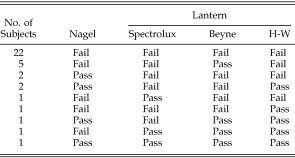If you want to acquire a pilots license, you need to pass medical checkup including a color vision test. If you fail the color blindness test you will get a second chance with a different color vision deficiency check. Unfortunately some researches from the United Kingdom could show, that those secondary color blindness tests are not reliable enough.

The Joint Aviation Authority (JAA) in Europe is the counterpart to the Federal Aviation Administration (FAA) of the United States. The JAA provides the standards of safety in aviation, including the rules on color vision tests for pilot candidates.
For the first color vision screening a set of 24 Ishihara plates are used. If you can identify the first 15 plates correctly without any hesitation you will pass the test. If not, you will get a second chance to find out if your color vision abilities are good enough.
The second test differs between countries. There are four different secondary color blindness tests approved by the JAA and in use:
- Nagel Anomaloscope
- Holmes-Wright Type A lantern
- Spectrolux lantern
- Beyne lantern
The anomaloscope is based on matching yellow to a mixture of red and green whereas you can adjust the brightness of yellow and the red-green mixture. The lanterns on the other side consist of several colored lights which have to be identified correctly. They are simulating signal lights used in aviation.
If you pass the second color blindness test you fulfill the color vision requirements for pilot candidates. Therefore one should think that those four tests are leading to the same result. But they are not.
A team around Prof. J. L. Barbur of the Applied Vision Research Center, City University, London, researched those different color vision deficiency tests (Color Vision Tests for Aviation: Comparison of the Anomaloscope and Three Lantern Types).

for Deuteranomalous Trichromats
As the results on the right hand side show, it depends on the color blindness test used in your country if you will pass or fail the test. The table shows pass/fail rates on all four secondary color vision tests for people suffering from the most common type of color blindness—deuteranomaly.
The researchers could also show, that all participants with a severe color vision deficiency will fail the tests. So the problem resides only for people with some mild form of color blindness.
Consistency is lacking in color vision testing and an aspiring professional pilot may be accepted without limitation in one country, and rejected outright in another. The different tests also reveal different aspects of color deficiency and the severity of outcome may or may not relate directly to the subject’s ability to discriminate colors.
As a conclusion it can be said that a more reliable and less variable internationally accepted color blindness test has to be found.

